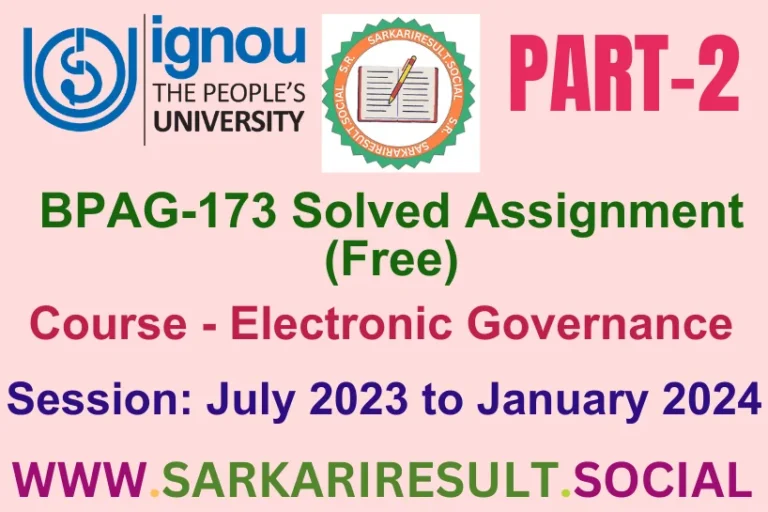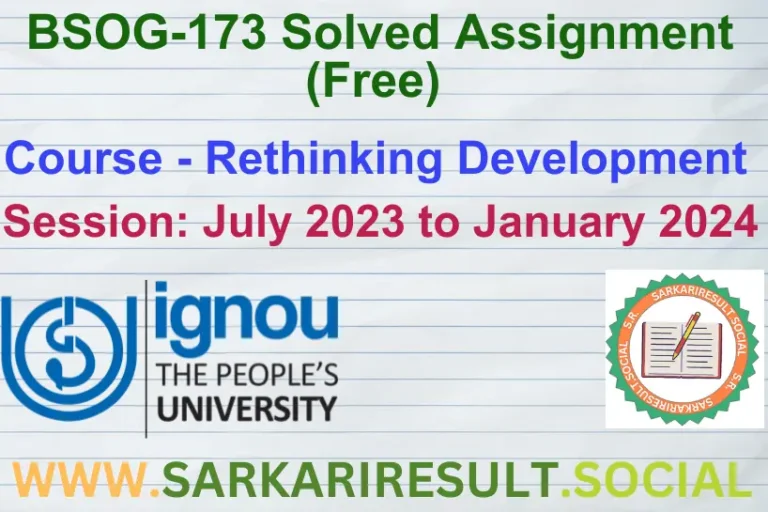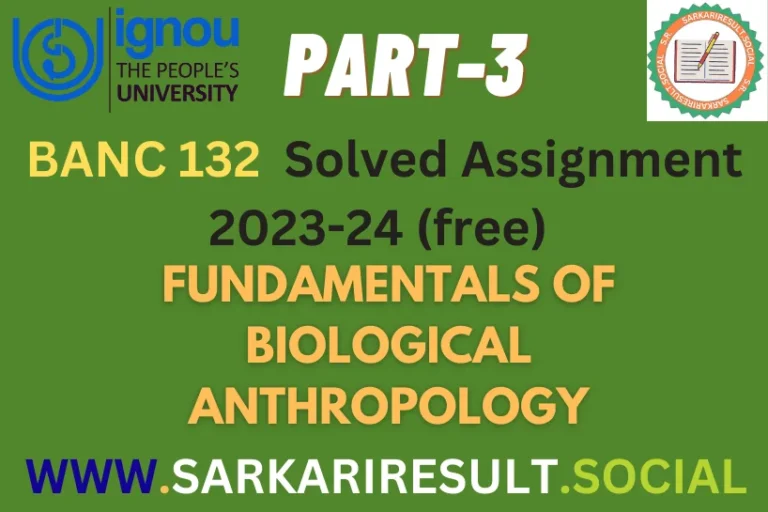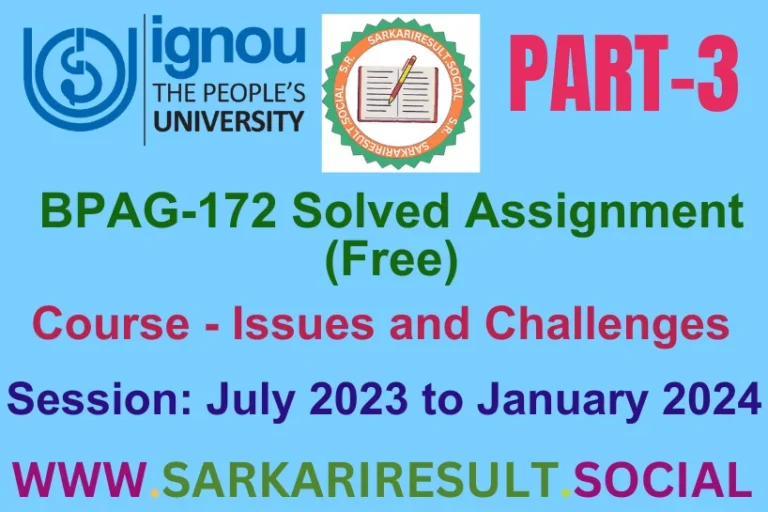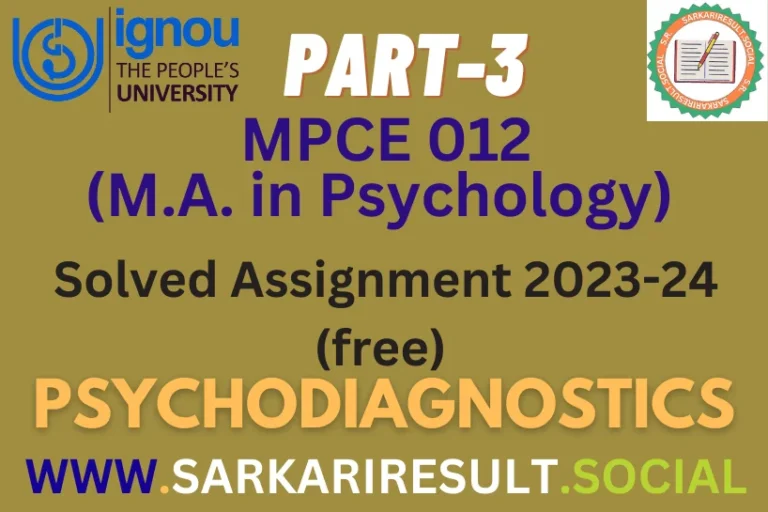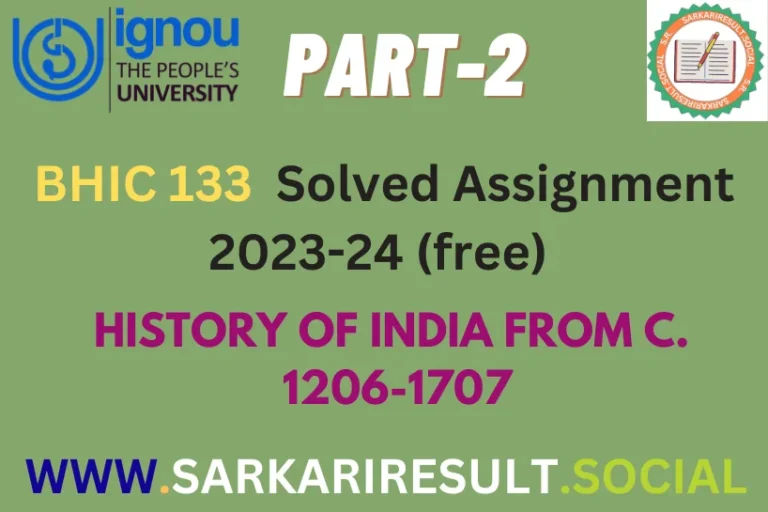BSOG 171 SOLVED IGNOU ASSIGNMENT FREE PART 1
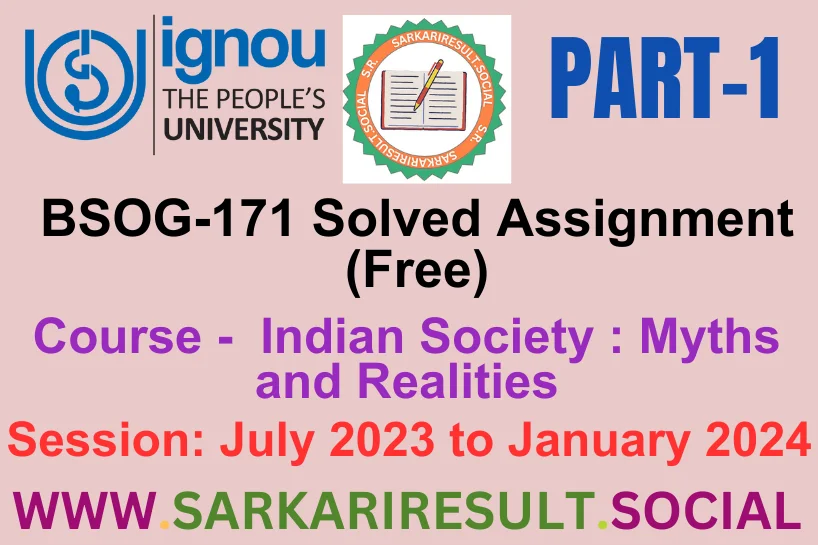
Welcome to the BSOG 171 SOLVED IGNOU ASSIGNMENT FREE PART 1 TMA. Assignment A features two insightful questions. In about 500 words each, explore the elements unifying Indian civilization and critically examine the colonial view of India. Our concise responses provide a clear and efficient path for comprehending these critical aspects of Indian society, ensuring a successful completion of your assignments. Our IGNOU Solved Assignments 2024 for this section serve as your creative guide.

Answer the following in about 500 words each.
Q.1 Examine the elements that have played a role in unifying Indian civilization.
Ans. India, a land of diverse cultures, languages, and traditions, has been historically united by various elements that contribute to the rich tapestry of its civilization. The unification of Indian civilization can be understood through cultural, religious, linguistic, and historical lenses.
1. Cultural Diversity and Syncretism:
– Unity in Diversity: India’s cultural diversity is unparalleled, yet a unifying factor is the spirit of syncretism. Different cultures have coexisted and influenced each other, resulting in a unique amalgamation.
– Shared Festivals and Traditions: Festivals like Diwali, Holi, and Eid are celebrated across the country, cutting across regional and linguistic boundaries.
2. Religious Pluralism:
– Coexistence of Religions: India is the birthplace of major religions, including Hinduism, Buddhism, Jainism, and Sikhism. The coexistence and intermingling of these religions contribute to a sense of shared heritage.
– Tolerance and Acceptance: The ethos of religious tolerance has historically been embedded in the Indian psyche, allowing people of different faiths to live together harmoniously.
3. Common Historical Threads:
– Ancient Civilizations: The existence of ancient civilizations like the Indus Valley Civilization provides a historical continuity that binds the subcontinent.
– Mughal and British Periods: Despite the Mughal and British periods, which brought diverse rulers and influences, India maintained a core cultural identity that persisted.
4. Linguistic Unity:
– Diversity of Languages: India is linguistically diverse with numerous languages and dialects. However, the adoption of Hindi as the official language, alongside English, has served as a bridge across linguistic barriers.
– Language as a Unifying Factor: The linguistic diversity, rather than being a source of division, has become a source of strength, contributing to a shared sense of identity.
5. Constitutional Unity:
– Preamble and Fundamental Rights: The Indian Constitution emphasizes the ideals of justice, liberty, equality, and fraternity, providing a common framework that transcends regional and cultural variations.
– Federal Structure: The federal structure accommodates diversity through states, but the constitutional thread unites them under a single sovereign republic.
6. National Symbols:
– National Flag and Anthem: Symbols like the national flag and anthem serve as unifying emblems, instilling a sense of national pride and identity.
– National Symbols: Icons like the Ashoka Chakra and national emblem symbolize unity in diversity.
7. Cultural Exchanges:
– Art and Literature: Cultural expressions, from classical dance forms to literature, have transcended regional boundaries, fostering a shared cultural identity.
– Cinema and Media: The influence of Indian cinema and media has played a role in shaping a collective consciousness, reaching audiences across linguistic and cultural divides.
8. Economic Interdependence:
– Economic Integration: The interdependence of various regions in economic activities creates a sense of unity. Trade, commerce, and the shared market contribute to a more connected and integrated nation.
9. National Integration Movements:
– Role of Leaders: Visionaries like Mahatma Gandhi and leaders of the independence movement emphasized the importance of unity. Their principles and efforts laid the foundation for a united India.
– Post-Independence Movements: Post-independence, movements like the one for linguistic states, ensured the accommodation of linguistic diversity within the national framework.
In conclusion, the unity of Indian civilization is a mosaic woven with diverse threads. Despite the multitude of languages, religions, and traditions, India has thrived as a vibrant and integrated civilization. The ability to harmonize differences and find common ground has been a testament to the resilience and inclusivity of Indian identity.
Q.2 Critically examine the colonial view of India.
Ans. The colonial view of India, shaped largely by European powers during their imperialist rule, reflects a perspective that has been widely criticized for its biases, ethnocentrism, and often distorted representations. Examining this view requires delving into the historical context, the impact of colonialism, and the narratives constructed by the colonizers.
1. Orientalist Lens:
– Biased Scholarship: Orientalism, as propagated by scholars like James Mill, presented India through a Eurocentric lens, depicting Indian culture as stagnant, irrational, and inferior to Western civilization.
– Distorted Historical Interpretation: The interpretation of Indian history, such as the portrayal of the Mughal era as one of despotism and decline, reflected colonial biases.
2. Economic Exploitation:
– Drain Theory: The economic view centered around the “Drain of Wealth” theory, positing that India’s wealth was siphoned off to benefit the British Empire. This oversimplified economic analysis ignored the intricate economic systems that existed in pre-colonial India.
– Deindustrialization: Policies like British trade monopolies and destruction of indigenous industries led to deindustrialization, impoverishing many and contributing to the perception of India as economically backward.
3. Cultural Condescension:
– Cultural Superiority: The colonial discourse often portrayed European culture as superior, dismissing indigenous practices as primitive. The imposition of Western education and values reflected a paternalistic attitude.
– Language Policies: The imposition of English as the medium of education marginalized native languages, contributing to a linguistic hierarchy that positioned English as a symbol of modernity.
4. Racial Hierarchies:
– Racial Categories: The development of racial categories like the Aryan-Dravidian divide perpetuated notions of racial superiority, with the Aryan race seen as more advanced. Such constructs reinforced social hierarchies and fueled divisions.
– Caste System: The British misinterpretation of the caste system, often viewed through a lens of untouchability and discrimination, added to the simplistic understanding of Indian society.
5. Historical Distortion:
– Selective Narratives: Colonial historians selectively presented narratives that justified British rule, emphasizing their role in bringing “civilization” to a supposedly backward society.
– Manipulation of Cultural Practices: Certain cultural practices were sensationalized or distorted to fit colonial stereotypes, contributing to the creation of an exoticized image of India.
6. Administrative Arrogance:
– Divide and Rule: The British employed policies of divide and rule, exploiting existing social, religious, and regional fault lines for administrative convenience. This exacerbated tensions and contributed to a fragmented view of India.
– Authoritarian Governance: The British administration often displayed an authoritarian approach, dismissing indigenous systems of governance and imposing structures that served colonial interests.
7. Resistance and Subaltern Histories:
– Silencing Indigenous Voices: The colonial view often marginalized or silenced indigenous perspectives, leading to an incomplete understanding of India’s history and diversity.
– Subaltern Histories: The resistance movements, like the Sepoy Mutiny of 1857, challenged the colonial narrative and offered alternative histories that emphasized agency and resilience.
In conclusion, the colonial view of India was a product of its time, characterized by Eurocentrism, racial hierarchies, and economic exploitation. This perspective has been rightly critiqued for its oversimplifications, biases, and distortions. A comprehensive understanding of India’s history requires engaging with diverse narratives that recognize the agency of the colonized and the complexities of pre-colonial societies.
Also See This: BSOG 171 SOLVED IGNOU ASSIGNMENT FREE PART 2

